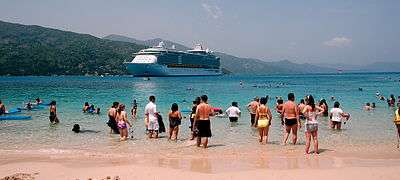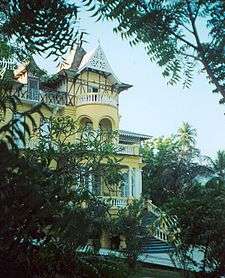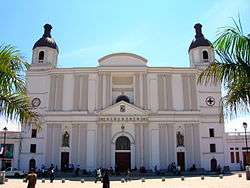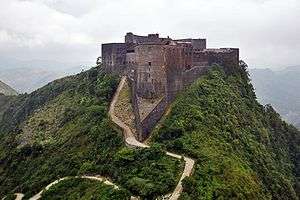Tourism in Haiti
Tourism in Haiti is an industry that has generated just under a million arrivals in 2012, and is one of the main sources of revenue for the nation.[1] With its favorable climate, second longest coastline of beaches and most mountainous ranges in the Caribbean,[2][3] waterfalls,[4] caves,[5] colonial architecture and distinct cultural history, Haiti has had its history as an attractive destination for tourists. However, unstable governments have long contested its history and the country's economic development throughout the 20th century.[6]
Overview

In 2012, the industry generated US$200 million (mostly from cruise ships).[1] In December 2012, the US State Department issued a travel warning about the country, noting that while thousands of American citizens safely visit Haiti each year, foreign tourists had been victims of violent crime, including murder and kidnapping, predominantly in the Port-au-Prince area.[7] Several hotels were opened in 2012, including a Best Western Premier,[8] a five-star Royal Oasis hotel by Occidental Hotel and Resorts in Pétion-Ville,[9] a four-star Marriott hotel in the Turgeau area of Port-au-Prince[10] and other new hotel developments in Port-au-Prince, Les Cayes, Cap-Haïtien, and Jacmel. Other tourist destinations include Camp-Perrin, Pic Macaya, and Île-à-Vache which includes Port Morgan and Abaka Bay resorts. The four-star all-inclusive 400-room beachfront Royal Decameron Indigo Beach Resort & Spa, Cote des Arcadins opened in December 2015.
The Haitian Carnival has been one of the most popular carnivals in the Caribbean. In 2010, the government decided to stage the event in a different city outside of Port-au-Prince every year in an attempt to decentralize the country.[11][12] The National Carnival which is usually held in one of the country's largest cities (i.e., Port-au-Prince, Cap-Haïtien or Les Cayes), follows the also very popular Jacmel Carnival which takes place a week earlier in February or March.[11]
History
Early boom

Like most tourism during the turn of the 19th century, tourism in Haiti ostensibly began with a series of popularized travelogues. Many of these travel narratives were themselves the result of the "opening up" of Haiti during the US Occupation (1915-1934) and Western capitalist expansion across the greater Caribbean. Authors invariably wrote on topics concerning racism and "The Negro Question" (i.e. whether Haiti and blacks in general were capable of civilization and self-rule), Haitian revolutionary intrigue, and voodoo mystique. The sights which these texts reported became the foundation for the country's more celebrated attractions following World War II.[13]
In the late 1940s and 1950s, tourists flocked to the waterfront area of Port-au-Prince, redeveloped to allow cruise ship passengers to walk from the docks to the famous cultural attractions. Among these attractions were the Moorish-styled Iron Market, where fine Haitian art and mahogany were sold, as the evenings were accompanied by dancing, casino gambling, or Voodoo shows. The exclusivity attracted the likes of Truman Capote and Noël Coward to the Hotel Oloffson, a 19th-century Gothic gingerbread mansion set in a lush tropical garden, which even was glorified in the Graham Greene novel, The Comedians.[6]
Haiti's brief tourism boom was wiped out by the rule of Francois "Papa Doc" Duvalier and his unstable government. However, when his son Jean-Claude "Baby Doc" Duvalier succeeded him as President for Life, tourism returned in the 1970s, and again Haiti was a hot spot tourist destination drawing an average of 150,000 visitors annually.[14] The resurgence of tourists flocking to Haiti's new seaside beach resort, included Bill and Hillary Clinton who honeymooned there in 1975. Vive la différence has long been Haiti's national tourism slogan,[15] and its proximity to the United States made Haiti a hot attraction until the Duvalier regime was ousted in 1986.[14]
Late 20th century
Since the second half of the 20th century, tourism in Haiti has suffered from the country's political upheaval. Inadequate infrastructure also has limited visitors to the island. Following the ouster of President Jean-Bertrand Aristide in 1991, tourism has recovered slowly. The Caribbean Tourism Organization (CTO) has joined the Haitian government in efforts to restore the island's image as a tourist destination. In 2001, 141,000 foreigners visited Haiti. Most came from the United States. Further improvements in hotels, restaurants, and other infrastructure still are needed to make tourism a major industry for Haiti.
Due to recent political instability, tourism (once a significant industry) has suffered in Haiti, with the exception of Labadee, a port located on the country's northern coast. Labadee is a resort leased long term by Royal Caribbean International. Although sometimes described in advertisements as an island in its own right, it is actually contiguous with the rest of Hispaniola. Labadee is fenced off from the surrounding area. The cruise ships dock at the pier, and passengers disembark directly to the resort without being given the opportunity to visit other parts of the country. Attractions include a Haitian flea market, traditional Haitian dance performances, numerous beaches, water-sports, and a water park.[16][17]
The city of Jacmel, due to its reputation as being less politically volatile, its French colonial era architecture, its colorful cultural carnival, pristine beaches, and a nascent film festival, has been attracting local tourists and a small amount of international tourism.[18]
Despite obstacles, Haiti's rich culture and history has allowed the country to maintain a moderate and potentially rising tourist industry.[19]

World heritage
These are the UNESCO's World Heritage Sites in Haiti:[20][21]
- Citadelle Laferrière, Milot. Constructed by King Henri I, the Citadelle Laferrière is a large mountaintop fortress in northern Haiti, and is the largest fortress in the Americas.[20]
- Sans-Souci Palace, Milot. The most important of nine palaces built by the king, as well as fifteen châteaux, numerous forts, and sprawling summer homes on his twenty plantations.[22]
- Buildings of Ramiers, Milot. One of the first buildings built after the Haitian Revolution.
See also
References
- Daniel, Trenton (8 July 2013). "Haiti hopes push to woo tourists pays off". The Burlington Free Press. Burlington, Vermont. pp. 5A. Retrieved 16 July 2013.
- "Geography: Haiti". Retrieved 29 September 2014.
- NgCheong-Lum, Roseline. Haiti (Cultures of the World). New York, NY: Times Editions Pte Ltd. (1995). p. 19. ISBN 0-7614-1968-3. Retrieved 29 September 2014.
- "In Haiti, Beauty That Plays Hard to Get (To)". Retrieved 23 November 2014.
- "The Caves of Haiti". Retrieved 23 November 2014.
- Clammer, Paul (1 February 2014). "Is Haiti The Caribbean's Best New Destination?". Retrieved 3 November 2014.
- "Haiti Travel Warning". Bureau of Consular Affairs. Archived from the original on June 23, 2013. Retrieved 26 July 2013.
- "Best Western International targets 120 new hotel projects in 2013". Traveldailynews.com. Archived from the original on 20 February 2013. Retrieved 24 July 2013.
- Charles, Jacqueline. "Petionville: Haiti gets new luxury hotel". MiamiHerald.com. Retrieved 24 July 2013.
- with Barbara De Lollis (29 November 2011). "Marriott announces first hotel in Haiti". Travel.usatoday.com. Archived from the original on 26 June 2012. Retrieved 24 July 2013.
- "More than 300,000 people celebrated the Carnival 2012 in Les Cayes". Haitilibre.com. 22 February 2012. Retrieved 24 July 2013.
- DeGennaro, Dr. Vincent. "Global Doc: Kanaval". Retrieved 23 November 2014.
- Landon Yarrington, "From Sight to Site to Website: Travel-Writing, Tourism, and the American Experience in Haiti, 1900-2008." M.A. thesis, Department of Anthropology, College of William and Mary.
- Clammer, Paul (1 February 2014). "Is Haiti The Caribbean's Best New Destination?". Retrieved 3 November 2014.
- Showker, Kay (2000). Northern and Northeastern Regions. p. 80. Retrieved 3 November 2014.
- Beaubien, Jason. "For Your Next Caribbean Vacation, Haiti ... Maybe?". All Things Considered. NPR. Retrieved 25 March 2014.
- Inskeep, Steve. "Royal Caribbean Provides Tourists, Relief To Haiti". Morning Edition. NPR. Retrieved 25 March 2014.
- "Haiti". Retrieved 23 November 2014.
- "9 Haitian Wonders". Retrieved 23 November 2014.
- "National History Park – Citadel, Sans Souci, Ramiers". UNESCO World Heritage. 1982. Retrieved 2007-08-16.
- "National History Park". World Heritage Site. 1982. Archived from the original on 2014-09-16. Retrieved 2014-09-22.
- Cheesman, Clive (2007). The Armorial of Haiti: Symbols of Nobility in the Reign of Henri Christophe. London: The College of Arms.
Notes
- Yarrington, Landon. 2009. "From Sight to Site to Website: Travel-Writing, Tourism, and the American Experience in Haiti, 1900-2008." M.A. thesis, Department of Anthropology, College of William and Mary.
External links

- Visit Haiti

